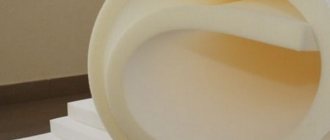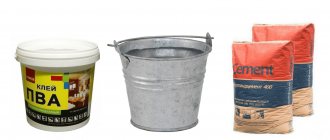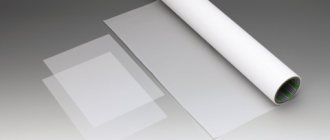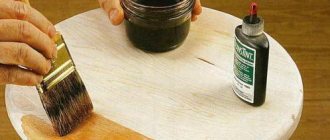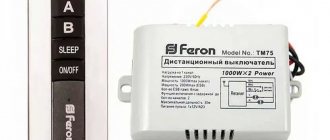All the numerous advantages of silicone sealants do not make this sealant ideal. In some cases, acrylic sealant will do the job better. Our article will tell you what the product is made from, what it comes in, and how it differs from its silicone “brother.”
Depending on what the composition becomes after use, all sealing agents are divided into three groups:
- Non-hardening compounds are sealants in the form of mastic, the most primitive of which is ordinary plasticine.
- Hardening compounds are silicone materials that harden as a result of a chemical reaction (vulcanization process).
- Drying compounds - such sealants become solid due to the gradual evaporation of the liquid.
This group includes acrylic sealants created on the basis of polymers. After application, the material only needs one day to dry. The one-component acrylic sealant is completely ready for use after opening the package. Other types of sealants are two-component formulations: their components must be pre-mixed before use.
Sealant: what is it and its properties?
The basis of the sealant is polymethyl methacrylate. Today this component is the most durable for creating plastic. In addition, the sealant consists of:
- thickeners;
- fillers;
- ammonia;
- defoamer;
- plasticizer;
- antiseptic impurities;
- Surfactant
Colored acrylic sealants
The product with an acrylic base remains elastic and can withstand loads and vibrations. Acrylic sealants can be painted any color or plastered over. Experts believe that to correct individual areas, it is better to use this product inside the room; outside, this sealant does not tolerate temperature changes and humidity so well.
It should be taken into account that in open outdoor areas the air has a detrimental effect on the material; for example, low temperature can partially destroy it.
Acrylic sealants are used at temperatures of +30 - +70 degrees Celsius. The material shows its best performance when exposed to open air, the seam does not change, no cracks appear, it tolerates frost and thawing well.
Regular acrylic has a white or transparent color, but there is also a painted material; it is often designed to resemble wood in many shades. This allows it to be used to seal wood.
Applying a new layer of sealant
You can apply a new layer of sealant to a degreased (just wipe the surface with alcohol) and dried surface (a hairdryer will help you here). Use a special sealant for plumbing fixtures, preferably a fungicidal one, to avoid mold.
| Modern plumbing silicone sealants can be applied even to a damp surface. | |
| Some sealants can even be painted. |
| 1. Carefully cut off the tip of the canister containing the new sealant. | |
| 2. Insert the sealant bottle into a special mounting gun. | |
| 3. Carefully, in an even layer, apply a thin layer of sealant to the joint. | |
| 4. Release the pressure on the gun by pressing the lever on the back of the gun - this will stop the pressure of the piston on the bottom of the bottle and the flow of sealant will be interrupted. | |
| 5. Wet your finger with dishwashing liquid. | |
| 6. Apply this liquid to the sealant with your finger. |
As a rule, sealant is applied using a balloon and a mounting gun, but special small tube-syringes are much easier to use.
Advantages and disadvantages
White acrylic has a number of undeniable advantages:
- attractive price, one and a half times lower than silicone sealant;
- ease of use. To seal a crack or seam, you should use this type of sealant; it is universal, simply apply and wash off or cut off with a knife;
- environmental friendliness of the material. White sealant contains no harmful or toxic components. There is no need to use any protective equipment during work. This product is not flammable and contains no solvents;
- the seam made can be restored and its color changed;
- The acrylic base is capable of allowing steam to pass through. Does not allow condensation from drops to accumulate on the seams, which will protect against fungus and mold;
- long service life. A high-quality sealant can withstand the rays of the sun, which, for example, cannot be said about polyurethane foam.
The disadvantage of acrylic sealants is that the material does not tolerate contact with water well; the base is an aqueous dispersion, which can dissolve after contact with water. This material is best used for sealing the seams of door and window jambs, as well as wooden coverings where moisture and water cannot penetrate.
There are water-resistant sealants. But prolonged contact with water can disrupt its structure. Acrylic-based sealant is not advisable for sealing cracks in rooms where moisture is almost always present.
What to look for when choosing a sealant?
In order not to make a mistake when choosing a sealant, you should pay attention to a number of factors. These include:
- compatibility of the sealant with the material of the surface you plan to seal;
- hardening time, permissible temperature limits;
- colorability;
- price;
- lifetime;
- composition and safety.
When choosing a sealed material, you need to determine the environmental conditions where the work is planned to be carried out. It is impossible to say unequivocally which sealant is better, silicone or acrylic. It all depends on the specific task and conditions of use. Decide what kind of work we are talking about - internal or external, what temperatures the material must withstand, what operational requirements you have, whether you plan to paint the surface after insulation.
There are also certain differences in the scope of application of sealants. For example, silicone is suitable for processing homogeneous surfaces (tiles, glass). Acrylic sealant, due to its texture, is capable of filling porous surfaces. For example, it could be concrete bases or wood. There are many more color variations for acrylic sealants. Due to this, it is easy to choose a color scheme and create a unified style for the interior and exterior.
According to performance characteristics, the service life of silicone is 20 years or more. With acrylic materials it is a little less so. When refinishing is needed, it is easy to determine by the external condition of the surface. As soon as cracks appear, get ready to renew.
Best use for acrylic sealant?
Acrylic-based sealant is considered universal among similar materials. The only thing that is important to consider is the impossibility of using it for the bathroom due to high humidity. Typically this material is used for connections that almost never require movement.
Acrylic sealant is also suitable for:
- restoration of interior items;
- laminate and wood flooring;
- sealing cracks.
In addition to being very suitable for sealing joints, this product can also be used as a construction adhesive for ceiling skirting boards. With its help, you can fill gaps in ceiling tiles, their formation appears due to an uneven surface. No special knowledge or skills are required to use this material.
The sealant should be applied to a clean and dry surface. For greater convenience, you should use a mounting gun, although this is not necessary. After 15 - 20 minutes. the treated surface must be covered with film, the material hardens within 24 hours if all conditions have been met - 50% humidity and temperature +23 degrees Celsius.
Removing the old layer of sealant
For good waterproofing of the space between the plumbing equipment and the tiled wall, sealant . It is extremely difficult to regularly replace the sealant layer with a new one, since it sticks tightly to the surface, but a special solvent can help you. However, try to initially choose a high-quality sealant for wet rooms and carefully apply it to the required joint.
The most affordable method that can be used to remove sealant without leaving home to purchase special equipment is mechanical action, that is, simply put, try to carefully cut off the old sealant by scraping, using a knife, scraper or spatula. The main thing here is not to overdo it, so as not to damage the work surface.
Special knife - scraper for removing sealant
If it is not possible to completely wipe off the sealant mechanically, then special means are used to remove traces of old sealant (chemical action); they can also be used to soften rather thick or well-adhering sealants that need to be washed.
Special products for removing silicone sealant
We can recommend such well-known products for removing silicone sealant as: Silicon-Entferner, Sili-Kill and Soudal Sealant Remove; they allow you to soften and remove old silicone applied to ceramic, enamel or plastic. But acrylic and polyurethane sealants can only be removed mechanically.
If you need to remove the old layer of sealant and apply a new one, use these tips.
| 1. Use a knife to remove the old sealant. Trim it on one side first. | |
| 2. Then trim the sealant on the other side and remove the sealant thread. | |
| 3. As a rule, it is not possible to cut the sealant cleanly. To remove residual sealant, moisten it with solvent. | |
| 4. Leave the solvent for about 30 minutes. | |
| 5. After this, scrape off the remnants of the already softened sealant. | |
| 6. Rinse the joint thoroughly with water and wipe with a dry cloth. |
How to choose a sealant?
In order to choose a quality product, you should take into account the need to work with a particular material. When restoring plastic, you need to understand that it has little adhesion to sealants. This means that for better adhesion to it you will need to buy a sealant with certain properties or use primers.
If you are dealing with aggressive environments, then you should purchase material that contains fungicides. You also need to remember that it is better to use it in non-residential premises. If necessary, you can use clear or white aquarium sealant, as it is particularly resistant to the aquatic environment. If you need to perform work in a room with high temperatures, it is better to purchase high-temperature sealants. The most common sealants in construction are acrylic, silicone sealant , polyurethane sealant and bitumen sealant.
Wood sealant
Silicone sealants: composition features, advantages, scope of use
Silicone-based sealants are made from a rubber base. These compounds are used to completely seal cracks and spaces. Once cured, the coating will last for several years. No special action is needed to dry the product applied to the surface; it hardens well at room temperature.
The sealant contains a plasticizer, which imparts the property of increased elasticity: a primer, which is responsible for the adhesion of the newly applied sealant to the surface; amplifiers that contribute to the formation of a more durable material structure; vulcanizer - turns silicone sealant into a viscous mass.
Silicone sealant for various applications Source oboiman.ru
Methods for removing traces of product use
After you have repaired a crack or seam, you need to clean the surface that received excess material. It is recommended to do this immediately after finishing work. But when the product has already dried, it will not be so easy to remove it; for this you can use a razor blade; all you need to do is clean the untidy areas with a few quick movements. Then you need to clean the surface with a brush. An ordinary stationery knife is also suitable for this work.
In more complex cases, you can use a solvent for this type of sealant. To do this, first put on a mask and be sure to use protective gloves. Half an hour after applying this product, you will need to wipe off the residue with a napkin. For the same purpose, you can remove excess sealant using white alcohol.
Preparing surfaces for sealant
Using silicone sealant is very easy. But first it is necessary to carry out preparatory work in the places where it will be used. Surface preparation consists of three stages:
- cleaning joints and seams in the bathroom from dirt and dust - you can use a vacuum cleaner for this purpose;
- degreasing surfaces intended for sealing with sealant - to do this, wipe the cleaned seams with acetone or alcohol;
- drying the work surface - wipe it dry or do it with a hair dryer.
Under what conditions should sealant not be used?
Sealing agents should not be applied during rain, snow or other precipitation. Despite the fact that sealants are frost-resistant and withstand frost at very low temperatures, the maximum permissible minimum for using acrylic sealant is −10 C°.
In winter, you should be doubly careful when applying sealant to the surface, which must be cleared of frost and ice in advance. Most often, the exterior treatment of the house with acrylic sealant is left for the autumn and spring.
What does silicone glue glue?
Today, a lot of different means and materials are used in construction - this is not surprising, since, with the development of technology, people have a choice of what to build from and with what. One such product is silicone glue. Its popularity is very high - this is not surprising if you read about its properties. Thanks to them, such adhesives are used in many industries, and, of course, in everyday life. Silicone adhesives have no analogues with equal properties. But today you will find the answer to the questions: “What does silicone glue glue?” and “When can it be used?” Along the way, of course, other points will be clarified.
What are silicone adhesives?
This is where you should start. This is important because before using any substance, you must understand not only how it works, but also what it is made of. So, silicone adhesive-sealant is a high-molecular organosilicon compound. All these difficult words for the average person fit into one expression - silicone. The material, which has unique properties, has been used in a variety of industries since its invention. One of these functions is precisely the role of a highly functional and multi-tasking glue.
What is the difference between silicone adhesive and sealant?
In fact, there are no significant differences between these two products. The composition of both glue and sealant is the same - there is no fundamental difference in the chemical structure of silicone. The quality of the product is also the same. The only difference is the scope:
• Adhesives are products used primarily to hold together small objects and sometimes seal tiny seams. Also, adhesives are packaged in small pipes and tubes and do not require a construction gun for use. In general, silicone adhesive is intended mainly for small jobs that do not require professional skills or technology. • Sealant is a product used to seal seams. These seams are quite large, that is, they have large linear dimensions - structures made of plastic, glass, metal, etc. To use a composition such as silicone adhesive-sealant, you need a construction gun or other similar equipment - this is necessary because sealants are used for large volumes of work that human hands cannot handle.
General properties
Transparent silicone adhesive has the following common properties for all products: • The consistency is such that it does not spread over the surface, while at the same time filling all the recesses and cavities. • Adhesion of silicone sealants and adhesives is quite high. Thanks to this, it can be used for gluing a wide variety of materials - glass, metal, ceramics, etc. • Modern compounds are non-toxic and therefore do not harm builders - that is, there are no special requirements for safety and working conditions. • Using adhesives is very simple, since there is no need for special skills or professional education. • Silicone glue hardens in a few hours - but the layer finally polymerizes only within 24 hours after application.
Seam properties
• Polymerization leads to the fact that the seam becomes not only strong, but also elastic. This allows you to bend, stretch, twist and compress the glued object - the performance characteristics do not change. Some products even allow you to stretch the seam up to a quarter of its nominal width. • Waterproof.
What problems do silicone adhesives solve?
The multitasking nature of such compositions has already been mentioned as a positive side, but this is worth dwelling on in more detail. So, silicone adhesives can perform the following functions: • Bonding materials that are inaccessible to other types of glue, • Sealing large-format seams (large structures, pipes, etc.), • Using a layer of glue as a rubber gasket. This can be convenient for various mechanisms and units.
Reliability of silicone adhesives. Exaggeration or not?
This question worries any buyer, not only of glue, but also of other products too. Regarding the first one, we can say that sellers and manufacturers are not exaggerating. Silicone adhesives are indeed extremely reliable, having all the declared characteristics. This can be judged, for example, by the fact that silicone glass glue is already used on an industrial scale - it is rare that an aquarium is connected using another material. Metal-plastic windows are also attached using the same glue. Long service without any problems is an indicator of quality. But only real silicone glue can show durability and quality. Some not very conscientious manufacturers add various additives to the composition of their products - from very cheap plasticizers to general garbage. Therefore, buying very cheap options should be avoided. It's better to spend a little more but get a quality product.
Types of Silicone Adhesives
Silicone adhesives, for the most part, have the same composition, which does not depend at all on their type, purpose, brand, etc. The basis is silicone rubber or its laboratory substitutes. Thanks to them, silicone adhesives harden in air. But to obtain special qualities, sealants are modified. The molecules are complicated by certain compounds, which provide the beneficial properties described above.
Ideal temperature and weather conditions for sealant use
Acrylic sealants are frost-resistant and are excellent for harsh climates. They maintain temperature perfectly: frost of −50 C° is not scary for them. Also, sealing agents can be waterproof, which allows them to be used for the outer layer, because neither rain nor other precipitation can harm them. Not all models are “friendly” with water, so it is necessary to clarify this issue in advance.
As for the maximum temperature at which the sealant retains all its necessary qualities, this threshold is quite high: 70 C° heat. Such a high temperature cannot be expected in our country, so there is no need to worry about the sealant.
Acrylic sealant can be used both inside and outside the house
Acrylic sealants are resistant to ultraviolet rays, which allows them to be used for outdoor work. However, the difference in the durability of indoor and outdoor sealant varies greatly: 10-15 years and 2-3 years, respectively.
